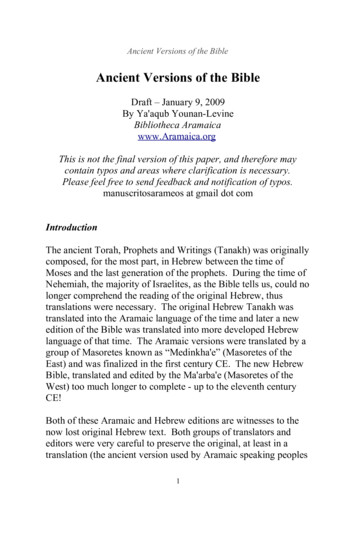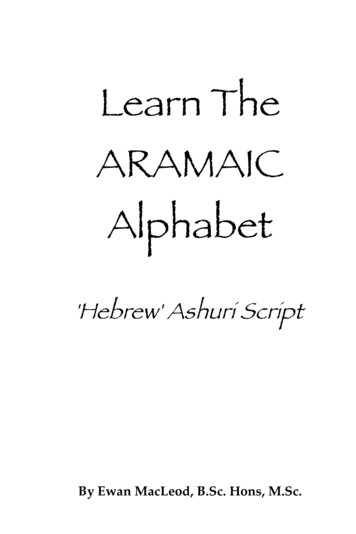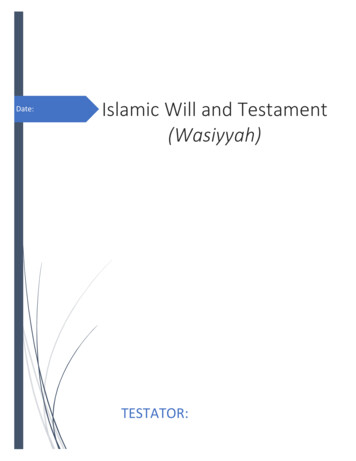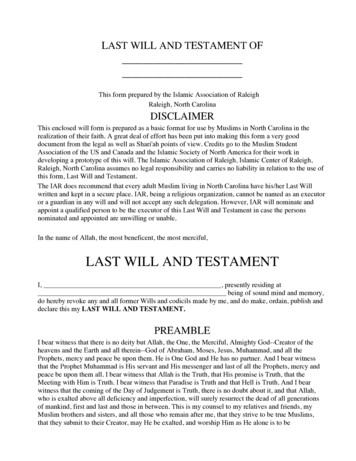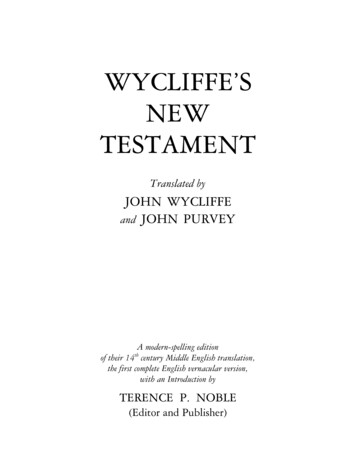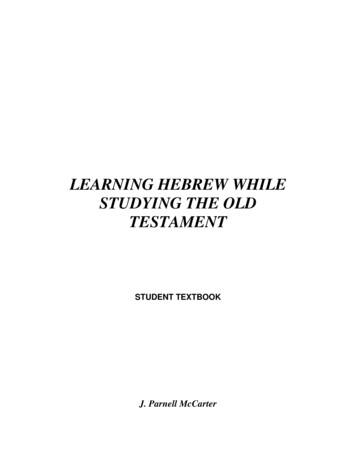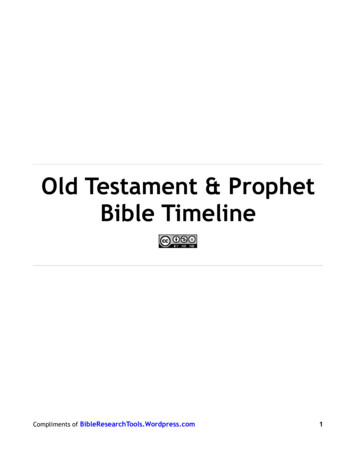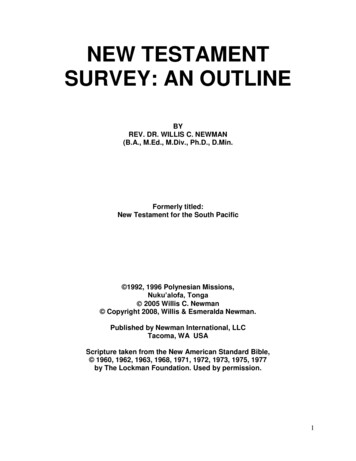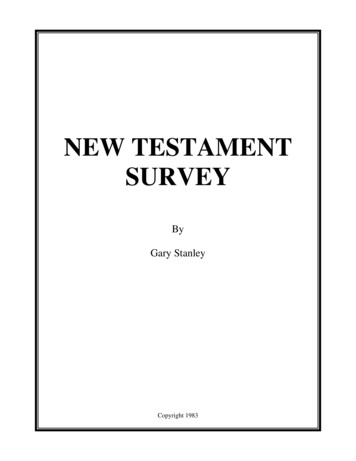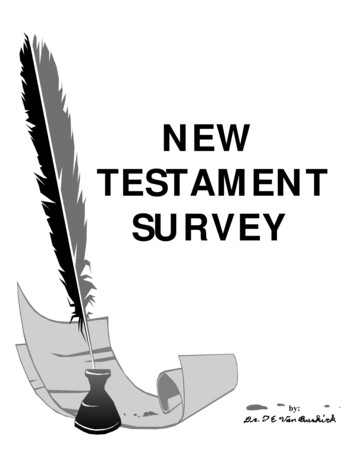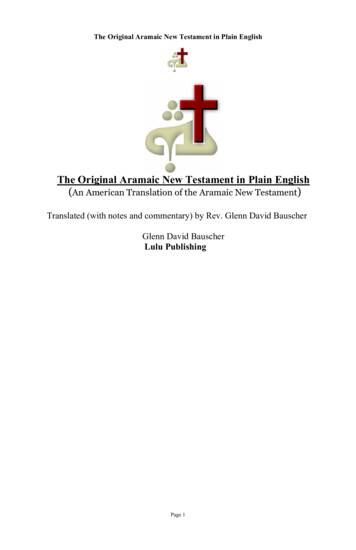
Transcription
The Original Aramaic ew Testament in Plain EnglishThe Original Aramaic ew Testament in Plain English(An American Translation of the Aramaic New Testament)Translated (with notes and commentary) by Rev. Glenn David BauscherGlenn David BauscherLulu PublishingPage 1
The Original Aramaic ew Testament in Plain EnglishThe Original Aramaic ew Testament in Plain English(An American Translation of the Aramaic New Testament)by Glenn David BauscherCopyright 2008 Lulu PublishingAll rights reserved. No part of this book may be reproduced or retransmitted in any mannerwhatsoever, except in the form of a review written permission from the publisher.Lulu PublishingPage 2
The Original Aramaic ew Testament in Plain EnglishTable of ContentsIntroduction. 4The Gospel According to The Apostle Matthew. 11The Gospel According To Saint Mark. 77The Gospel According To Saint Luke . 115The Gospel according to The Apostle John. 197The Acts of The Apostles. 249The Epistle of The Apostle Paul to the Romans. 311The First Epistle of The Apostle Paul to the Corinthians . 339The Second Epistle of The Apostle Paul to the Corinthians. 365The Epistle of The Apostle Paul to the Galatians . 383The Epistle of The Apostle Paul to the Ephesians . 394The Epistle of The Apostle Paul to the Philippians . 403The Epistle of The Apostle Paul to the Colossians . 410The First Epistle of The Apostle Paul to the Thessalonians. 417The Second Epistle of The Apostle Paul to the Thessalonians. 424The First Epistle of The Apostle Paul to Timothy. 428The Second Epistle of The Apostle Paul to Timothy. 438The Epistle of The Apostle Paul to Titus. 445The Epistle of The Apostle Paul to Philemon . 450The Epistle of The Apostle Paul to the Hebrews. 453The Epistle of The Apostle James. 481The First Epistle of the Apostle Peter. 490The Second Epistle of The Apostle Peter . 499The First Epistle of The Apostle John. 505The Second Epistle of The Apostle John. 512The Third Epistle of The Apostle John . 513The Epistle of The Apostle Jude . 514The Revelation of Yeshua The Messiah . 516Epilogue. 558Bibliography:. 559Page 3
The Original Aramaic ew Testament in Plain EnglishIntroductionThis volume is a translation of what this author believes to be the original AramaicNew Testament as first written by The Apostles and Evangelists Matthew, Mark,Luke, John, Paul, Peter, James and Jude.This translation of The New Testament is different from most New Testamenttranslations in that most are translated from Greek or Latin, whereas this is fromAramaic. Aramaic was the language of Jesus of Nazareth (“Yeshua Netsari” inAramaic) and of his twelve disciples. The Peshitta New Testament is the onlycomplete Aramaic New Testament known today which is held by a significantChristian denomination to be the original text written by the Apostles. The Churchof The East has always held to this text as the original writing of the Apostles,preserved with word for word accuracy by its Scribes for nearly two thousand yearswith meticulous care and reverence.This prose translation is taken from the author’s The Aramaic-EnglishInterlinear Translation of The New Testament (a very literal translation withthe Aramaic words side by side with their English translations in parentheses in thesame word order as the Aramaic, which reads right to left).Why should anyone be interested in such a translation? The answers are manifold andI cannot address them all here. The most important reason is that the original Gospels(and Epistles as well) were written in Aramaic and later translated into Greek forGreek speaking Romans. Josephus addresses the language of the first centuryIsraelites in his 1st century volumes of Jewish history. He wrote in Aramaic andtranslated his works into Greek later. He also testifies plainly that Greek was not thelanguage of his Israeli countrymen (born AD 37 and died after AD 100) and thatGreek was not spoken by the vast majority of Jews at that time.Josephus provides almost all the historical information of first century Israel availabletoday. Every serious student of the New Testament has consulted Josephus forbackground information on that time period in Israel.Here is a statement from Josephus : “I have also taken a great deal of pains toobtain the learning of the Greeks, and to understand the elements of theGreek language, although I have so accustomed myself to speak our owntongue , that I cannot pronounce Greek with sufficient exactness. Forour nation does not encourage those that learn the language of manynations. On this account, as there have been many who have done theirendeavors, with great patience , to obtain the Greek learning, there havehardly been two or three who have succeeded herein , who wereimmediately rewarded for their pains.” – Antiquities XX, XI 2.(published circaA.D. 93)Josephus, a learned Priest and Pharisee of his time, wrote that he did not know Greekwell enough to speak it fluently; he knew a few who had learned it well. The maintruth to be gleaned here is that Greek was not the language of Israel, nor a secondlanguage. It had to be studied deliberately to be learned, and it was apparentlydiscouraged by the Jews.In A.D. 77, Josephus wrote his Jewish Wars in Aramaic and later translated it intoGreek for the Greek- speaking Roman citizens. Even his later Antiquities, quotedabove, shows that Josephus was not fluent enough in Greek to compose his severalPage 4
The Original Aramaic ew Testament in Plain Englishvolumes in that language. The Jewish rabbis of that time forbade the teaching ofpagan tongues to their young men. They taught that it was preferable to feed one’s sonthe flesh of swine than to teach him Greek.Josephus elsewhere wrote that he wrote his works “in the language of his country”and later “translated his history into Greek”. This establishes that Greek was not thelanguage of Israel.This historical information is valuable in determining what the language of theoriginal NT was. The New Testament was written by Jews in Israel, for the mostpart, and to Jews originally, since they were the original Christians. Even thechurch in Rome was established by Jewish converts who had been dispersed fromIsrael and spoke Aramaic.Aramaic had been the language of the Holy Land and the Middle East since the 7thcentury BC. It was imposed on that part of the world by The Assyrians when TheAssyrian Empire ruled that area of the world in the ninth through seventh centuriesBC. Greek never supplanted Aramaic in that area.Greek did spread in the western empires of Alexander The Great and the Caesars.That is why the Hebrew Old Testament was commissioned by Greek King Ptolemy ofEgypt around 285 BC to be translated into Greek, so he and Greek speaking people ofAlexandria, Egypt, could read the Jewish scriptures in their own language.It makes no sense whatever to suppose the original Gospels were written in Greek.The first Christian churches were established by Jewish disciples and converts of TheMessiah Yeshua (Jesus) in Israel, Samaria , in Asia Minor, Syria and Mesopotamia,and later in the cities of Rome, Corinth, Ephesus, Galatia, Philippi, etc. , all of whichwere inhabited by colonies of Jews who had been dispersed there centuries before bythe Babylonian, Persian and Greek persecutions of each respective empire over aperiod of seven centuries. A careful reading even of the epistles of Paul reveals that hewas writing to churches comprised of Jews familiar with the OldTestament Hebrew writings and laws and to whose ancestors Paul refersas “our fathers” (See 1 Corinthians 10:1, Romans 2:17-4:25 , Galatians 2:15 and ofGentiles as well. The Jews took the Aramaic language with them whereverthey went, as it had replaced Hebrew as the language of Israel in theBabylonian captivity in the 6th century BC.Aramaic was the lingua franca of the Holy Land, Syria, Mesopotamia, Asia Minorfrom 700 BC to AD 700. The Jews of first century Israel would have been unable toread Greek gospels (not to mention unable to write them). The order of gospelpreaching and writing was always “To the Jews first and also to the Gentiles.”Every church would have wanted a copy of the original readable by Jews and Gentiles,which would require Aramaic first to the Jews, Syrians, Assyrians, Persians and mostAsians, and Greek for most Roman Gentiles.The Greek New Testament testifies that Aramaic was spoken by the Judeans ofChrist’s time. The New International Version uses the word “Aramaic” seven timesin the Gospels and Acts to indicate the language of Israel and its inhabitants. Greek isnever mentioned as the language spoken by any of the disciples or any Israelite. TheApostle Paul is referred to as knowing at least some Greek in Acts 22:37, but a fewverses later he is speaking to the Jews in Aramaic. Paul was not from Israel; he wasfrom Tarsus of Cilicia, a center of Greek learning in the Eastern world. Serious studyof the above seven references to Aramaic makes clear the fact that the Jews of Israelspoke Aramaic as their native language.For an extensive discussion and evidence supporting Aramaic originals, please see myweb site: aramaicnt.comPage 5
The Original Aramaic ew Testament in Plain EnglishI have written three books which bear on the subject : Divine Contact-The Original NTDiscovered , The Aramaic-English Interlinear New Testament andJegar Sahadutha-“Heap of Witness”.One question many ask about the Aramaic text is, “Are there major differences in thistext as compared to other translations? The answer is that about 95% of the text is thesame as other New Testaments, but the 5% difference is a really interesting ,significant and powerful 5% content!Let me give an example in Mark 14:61-64:61. But he was silent, and he did not answer him anything. Andagain, The High Priest asked him and said, "AAre you The Messiah,The Son of The Blessed One?"62. But Yeshua said to him, "II AM THE LIVING GOD,GOD and you shallbehold The Son of Man sitting at the right hand of Power andcoming on the clouds of Heaven."63. But The High Priest ripped his tunic and he said, "WWhy now do weneed witnesses?"64. “BBehold, you have heard the blasphemy from his own mouth. Howdoes it appear to you?” But they all judged that he deserved death.Do you see what I mean? Our Lord used the Aramaic phrase, “Ena Na”, whichsignifies a Divine utterance in 97% of the places it is found in The Peshitta OldTestament- “I am The LORD your God”, “I am The LORD who heals you”, etc, inhundreds of references. Yet Our Lord used this phrase of Himself about thirty times.Let me give one more example, this one in John’s Gospel:1.2.3.4.Therefore Yehuda led a troop also from the presence of the ChiefPriests and the Pharisees. He led the guards and came there withtorches and lamps and weapons.But Yeshua, because he knew all these things had come upon him,went out and said to them, "WWhom are you seeking?"They were saying to him, "YYeshua the Nazarene." Yeshua said tothem, "II AM THE LIVING GOD."GOD But Yehuda the traitor was alsostanding with them.And when Yeshua said to them, "II AM THE LIVING GOD”,GOD theywent backward and they fell on the ground.Again we find Our Lord used the same phrase, “Ena Na”, and the band of soldiers fellbackward to the ground! This is powerful testimony that Yeshua claimed to be GodHimself, when He was to be arrested and later when put under oath by The HighPriest of Israel. It was the testimony of Jesus, quite literally, and when He would havechosen His words precisely and appropriately. The common people may have beenignorant of the sign
The Original Aramaic ew Testament in Plain English Page 6 I have written three books which bear on the subject : Divine Contact-The Original NT Discovered , The Aramaic-English Interlinear New Testament and Jegar Sahadutha-“Heap of Witness”. One question many ask about the Aramaic text is, “Are there major differences in this text as compared to other translations? The answer is that .
